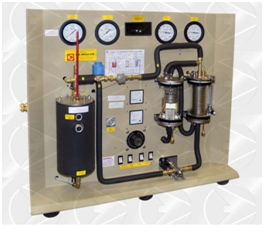● Enables demonstration and investigation of the combined Rankine and Vapour Compression Cycle
● Is an example of a refrigerator or heat pump driven by a Heat Input as opposed to the more usual work input
● Uses hot water as the ‘high grade’ heat source, thus limiting the maximum temperature to 100oC
● Evaporation and Condensation may clearly be seen through glass cylinders
● As a heat pump, the unit shows approximately the same primary energy ratio as a work-driven heat pump
● All important components are mounted on the front panel and quickly responds to a change in operating conditions.
● Optional Solar Panels available
● Two Year Warranty
Introduction
Refrigerators and Heat Pumps are machines which extract heat from a low temperature region and reject heat to a region at a higher temperature. If the prime function of the machine is to extract heat from low temperature region, the machine is a REFRIGERATOR. Conversely, if the prime function is to deliver heat at a useful temperature, the machine is a HEAT PUMP.
The Laws of Thermodynamics indicate that the transfer of heat from a cold to a hot body is impossible without the aid of external assistance, i.e. a high grade energy input. This input can be in the form of a WORK TRANSFER or of a HEAT TRANSFER AT A HIGH TEMPERATURE.
Since work is the most valuable form of energy, the quantity of work required for a given heat transfer from a cold to a hot body, will be less than if a high grade heat input is employed. However, work is usually derived from a very high grade heat input in a Thermal Power Station or other Prime-Mover. As the thermal efficiency of these is usually between 25 and 35% there can be an overall advantage in using a heat input to drive a heat pump or refrigerator.
The Combined Rankine and Vapour Compression Cycle.
The pressing need to conserve fossil fuels has aroused interest in two distinct possibilities associated with refrigeration:
a) Refrigerators which will operate from non-fuel consuming input (e.g. solar radiation, waste heat, geothermal heat).
b) Combined prime movers and heat pumps which burn fuels, but which make more heat available for intermediate grade heating purposes than was available from the fuel consumed.
The Combined Rankine and Vapour Compression Cycle makes both of these possible. In a Combined Rankine and Vapour Compression Cycle, a high grade heat input generates high pressure vapour in a boiler. This vapour expands in a turbine producing work, and then passes into a condenser where it is liquified by rejecting heat. The liquid is then pumped back into the boiler for re-evaporation.
The work produced by the turbine drives a conventional vapour compression cycle refrigerator or heat pump.
Assuming that the same fluid is used throughout, the turbine and compressor can discharge into a common condenser. Neglecting heat losses, it will be seen that the ratio
Intermediate Grade Heat Delivered = QH + QL is greater than unity
High Grade Heat Input QH
The effectiveness of the combined Rankine and Vapour Compression Cycle depends upon the temperatures at which,
i. heat is supplied at the boiler,
ii. heat is available to the evaporator,
iii. heat is rejected at the condenser,
iv. The efficiency of the expansion and compression processes.
The unit will be a valuable teaching aid for students of:
● Refrigeration & Air Conditioning
● Building Services
● Mechanical Engineering
● Plant and Process Engineering
● Energy Conservation
● Energy Management
● Chemical Engineering
● Food Technology
● Marine Engineering
● Agriculture Engineering
Experimental Capabilities
The following experiments can be performed:
● Analysis of the combined Rankine and Vapour Compression Cycle.
● Demonstration of the characteristics of an ejector or thermo compressor.
● Production of performance curves as a refrigerator and comparison with ideal
o Rankine/Vapour Compression cycle.
● Production of performance curves as a heat pump and comparison with ideal
o Rankine/Vapour Compression Cycle.
● Investigation of entrainment mass ratio at various pressures.
● Demonstration of ‘adiabatic’ mixing of hot and cold vapour.
● Demonstration of ’adiabatic’ throttling
Description
The unit may be regarded as a combined heat engine and a refrigerator/heat pump.
The system powering the refrigerator/heat pump works on the well-known Rankine cycle (frequently used in steam power plants.) In this cycle the unit takes in heat at a very modest temperature (about 90o C) and rejects heat at the condenser temperature (about 30o C). The work output of this engine is in the form of the kinetic energy of a jet instead of shaft work as is normal with a Rankine cycle.
The refrigerator/heat pump operates on the Vapour Compression Cycle and uses the output of the Rankine Cycle (i.e. the kinetic energy of the jet). It takes in heat at a low temperature in an evaporator and rejects heat at a higher temperature using the same condenser as the engine.
Both the Rankine Power Plant Cycle and the Vapour Compression/Heat Pump Cycle are included in most courses of study for young engineers. The Hilton Vapour Jet Refrigerator/Heat Pump R853 demonstrates practically, the potential of combining these cycles so that a heat pump or refrigerator can be run from a heat output.
Controls and operation
The unit has three simple controls:
Condenser cooling water flow rate – this, in conjunction with the inlet temperature of the cooling water, determines the temperature and pressure in the condenser, and thus the temperature at which heat is rejected.
2. A variable transformer – this varies the heat input to the electric heater in the evaporator, which in turn controls the evaporation temperature. A voltmeter and ammeter indicates the energy input to the heater.
3. A manually adjustable throttle valve – this is placed between the vapour generator and the nozzle and enables the unit to be operated below the maximum pressure.
Instrumentation is provided for temperature and pressure measurement, the heat input to the evaporator and the water flow rate. The mass flow rates of the refrigerant at the evaporator can be readily obtained from the measured energy transfer rates and the enthalpy changes.
The heat transfer at the refrigerant vapour generator is obtained by the difference between the heat transfer at the condenser and that at the evaporator and the heat transfer rate to or from the surroundings.
It should be noted that the performance of all vapour power plants, refrigerators and heat pumps falls as the condenser temperature rises. This is true of the Vapour Jet Refrigerator/Heat Pump and it is recommended that, if a useful range of test conditions is to be investigated, the condenser cooling water temperature should not exceed 22° C.
Optional Solar Panels and Installation Package F821S
The R853 Vapour Jet Refrigerator/Heat Pump may be run from any source of hot water at a sufficiently high temperature, i.e. about 90° C.
In locations where conditions are suitable, the F821S Solar Panels & Installation Kit enables these units to be run from hot water generated in solar panels. The kit, which is for on-site assembly and installation, includes the solar panels and all the components required for connection to the unions provided on these units.


